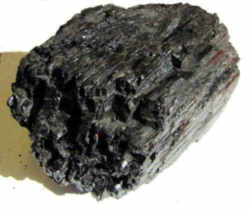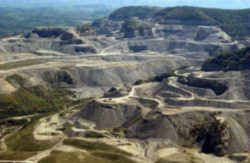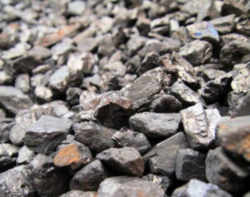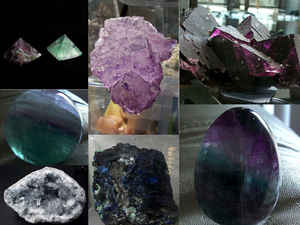
Kentucky Symbols
Kentucky State Mineral
Coal

Adopted on July 15, 1998
In 1998, students from Louisville petitioned the State Legislature to make coal the official State Mineral. One problem is that scientifically coal is a rock, not a mineral. Minerals are the building blocks of rocks. Rocks are composed of many minerals. But legally, coal is considered a mineral resource and is taxed as a mineral. The legislature passed the resolution on July 15, 1998, and coal is now the official State Mineral of Kentucky.
Kentucky ranks as one of the top three producers of coal in the United States, with 150 to 160 million tons of annual production. Coal is mined in two coal fields; the Western Kentucky Coal Field and the Eastern Kentucky Coal Field. Coal is mined because coal is a rock that burns. Most of the coal mined in Kentucky is burned to produce electricity at power plants.
Kentucky State Mineral: Coal
Kentucky's State Mineral is coal (a Rock)

Coal: One of the world's major sources of energy. In the United States, coal provides approximately 23% of all the energy consumed. Coal is used to produce more than half of all the electrical energy that is generated and used in the United States. Coal is a very complex and diverse energy resource that can vary greatly, even within the same deposit. In general, there are four basic varieties of coal, which are the result of geologic forces having altered plant material in different ways. These varieties descended from the first stage in the formation of coal: the creation of peat or partially decomposed plant material.
Lignite: Increased pressures and heat from overlying strata causes buried peat to dry and harden into lignite. Lignite is a brownish-black coal with generally high moisture and ash content and lower heating value. However, it is an important form of energy for generating electricity. Significant lignite mining operations are located in Texas, North Dakota, Louisiana, and Montana.
Subbituminous Coal: Under still more pressure, some lignite was changed into the next rank of coal subbituminous. This is a dull black coal with a higher heating value than lignite that is used primarily for generating electricity and for space heating. Most subbituminous reserves are located in Montana, Wyoming, Colorado, New Mexico, Washington and Alaska.
Bituminous Coal: Even greater pressure results in the creation of bituminous, or "soft"coal. This is the type most commonly used for electric power generation in the U.S. It has a higher heating value than either lignite or subbituminous, but less than that of anthracite. Bituminous coal is mined chiefly in Appalachia and the Midwest. Also used to make coke.
Anthracite: Sometimes also called "hard coal,"anthracite forms from bituminous coal when great pressures developed in folded rock strata during the creation of mountain ranges. This occurs only in limited geographic areas - primarily the Appalachian region of Pennsylvania. Anthracite has the highest energy content of all coals and is used for space heating and generating electricity.
Coal is a sedimentary rock of biochemical origin NOT Mineral

- Sedimentary Rock Type: Biochemical
- Related to: Shale, sandstone and limestone
- Color: Generally black to dark brown or gray
- Texture: Amorphous and glassy to coarse fragments
- Origins: Swampy environments
- Common Minerals: Graphite , pyrite and jet (a mineraloid)
- Uses: Source of energy, lubricant, pigment and source of carbon for industrial purposes
Coal is a readily combustible rock containing more than 50 percent by weight of carbonaceous material, formed from compaction and induration of variously altered plant remains similar to those in peat [adapted from AGI's "Glossary of Geology"]. Most coal is fossil peat. Peat is an unconsolidated deposit of plant remains from a water-saturated environment such as a bog or mire; structures of the vegetal matter can be seen, and, when dried, peat burns freely [adapted from AGI's "Glossary of Geology"].

The numerous layers of coal beds in both of Kentucky's coal fields are intermixed with shale and sandstone (and rarely with thin limestones). Most of the major coal beds (there are about 45 to 50 in eastern Kentucky) were formed as widespread peat swamps or mires during the Pennsylvanian Period. During the Pennsylvanian Period the area that is now Kentucky was near the equator and had a climate much like that of modern Indonesia. Tropical climates allowed lush vegetation to accumulate into widespread peats.
All the mined coal in Kentucky is bituminous. The original peat deposits or layers that later became coal were laid down with other sediments during the Pennsylvanian Period (sometimes called the Coal Age). The Pennsylvanian Period started about 323 million years ago, ended about 290 million years ago, and lasted about 33 million years. If you want to learn more about life in the Pennsylvanian peat swamps, see the Pennsylvanian fossil page.
The lignites from the Jackson Purchase Region come from a variety of deposits from the late Cretaceous Period (part of the Age of Dinosaurs; the coals were deposited as peats as early as 70 million years ago) through the Tertiary Period (till about 10 million years ago).
Kentucky Law
The law designating coal as the official Kentucky state mineral is found in the Kentucky Revised Statutes, Title 1, Chapter 2, Section 2.094.
TITLE I - SOVEREIGNTY AND JURISDICTION OF THE COMMONWEALTH.
CHAPTER 2 - CITIZENSHIP, EMBLEMS, HOLIDAYS, AND TIME.
Universal Citation: KY Rev Stat § 2.094 (2013)
2.094 State Mineral.
Coal is named and designated as the official mineral of Kentucky.
Effective: July 15, 1998
History: Created 1998 Ky. Acts ch. 230, sec. 1, effective July 15, 1998
Minerals, & Gems

Gemstone, Minerals, Rocks






